Diet meals step-up with more premium, gourmet offerings, test reveals

“A lot of people steer away from frozen diet meals in grocery stores because they don’t think they are as appealing as going to a restaurant,” but in the past few years manufacturers of frozen and shelf-stable diet meals are stepping up their game, Jessa Barron, content manager for the consumer research firm NextAdvisor, told FoodNavigator-USA.
She recently helped conduct NextAdvisor’s sixth annual diet food taste test, in which 14 adults were asked to evaluate meals from seven major diet delivery services on taste, appearance and satiety. In the course of preparing the meals she noticed that some of the programs “have become more gourmet and no longer offer the basic meals you would expect.”
She noted that compared to prior years, several of the meals used more premium ingredients and offered more sophisticated flavor profiles, such as a shrimp and mango bisque and a sweet and sour chicken “that looked like something you would order out and not get to eat on a diet.”
She added that the meals also looked more like “complete dinner meals,” with different food groups covered, compared to the past where a basic meal might be a small serving of lean meat and pasta or an egg white omelet that would leave consumers wanting more.
Balance taste and satiety
She acknowledged that the new meals still meet the study’s criteria of 1,200 to 1,400 calories a day, but that they likely made up for the difference by offering slightly smaller, but richer portions, or using more calorie conscious ingredients so that the appearance of the size remained the same.
She said her observations also were echoed by the survey participants, who sampled breakfasts, lunches and dinners from each diet delivery service over the course of three days without knowing which service made each meal.
However, she noted, that the most appetizing meals often were rated lower for satiety. For example, study participants loved the taste and appearance of a dinner with two turkey burger sliders, but said it wasn’t enough food to make them feel full.
Conversely, some of the most hearty meals were scored down for flavor and appearance, Barron said. Specifically, she noted that the Fresh n’ Lean meals, which were all organic, vegan and gluten-free lost points for appearance and flavor but came in high for satiety.
Barron suggested a potential factor could be that most Americans expect animal protein, and might have been put off by its exclusion and not known where to focus their attention when they were looking at the meal. Likewise, if they are unfamiliar with vegan fare, they might not have a frame of reference by which to fairly compare the flavor.
Companies offering plant-based and vegan frozen or shelf stable meals might want to offer additional education or explanation of their meals so that consumers better understand they offer as much protein as meals with animal meat.
Other lessons learned
Other lessons learned from the study that easily could apply to frozen and shelf stable meals, regardless of category placement, include:
Be careful with eggs – Eggs are a common staple in frozen breakfasts, but also were off putting to many testers, who complained they were rubbery or watery, Barron said.
If meat is included, freeze it – Shelf stable meals with meat that was packaged safely, but which was not frozen, often scored lower than meals with frozen meat, Barron noted. She explained that because the meals were prepared for the testers in advance, they did not know which meats were shelf stable verses frozen, but there was a clear taste difference.
Offer a wide variety of meals – Diet delivery services should include enough different meals in their rotations that consumers do not have to repeat a dish within two weeks, Barron suggested. She noted that repetitiveness could cause consumers to stray, and sales to fall.
Be transparent with imagery – A premise for the survey was that the average consumer often doesn’t know without trying if the diet meals are as mouthwatering as the pictures on their packages. Barron noted that some delivered on the promise, and others did not, which could stop consumers from repeat purchases.
To read the full results from the taste test, including details on the meals and additional services provided by the brands included in the review, click HERE.















